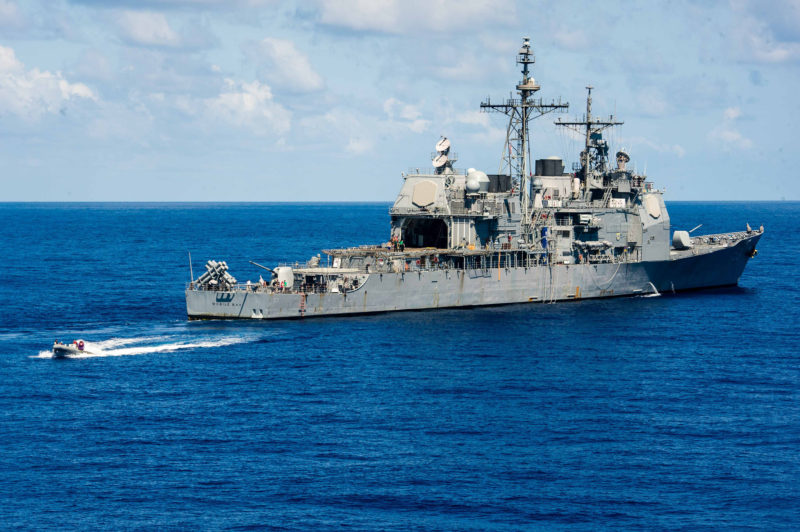In early February 2017, two military aircraft, one Chinese and the other American, flying over a disputed part of the South China Sea came inadvertently close to one another in what was described as an “unsafe” encounter. While this is the first publicly confirmed incident since May 2016, there have been many points of contention between China and the U.S. in the South China Sea. Diplomacy there between the two countries has been rocky, as both powers hold contrasting views. China is “deeply suspicious” of any U.S. military activity nearby; meanwhile the U.S. has criticized China’s militarization of its outposts in the area and stressed the need for periodic air and naval patrols to maintain freedom of navigation.
China maintains its position, arguing that the 1943 Cairo Declaration and the 1945 Potsdam Declaration stated that Japan had to return all Chinese territory seized during the war. This included the Spratly Islands, which are among the largest groupings of land in the South China Sea. In comments made by Chinese Foreign Minister Wang Yi in February, he argued that once China took back the Spratly Islands and resumed exercising sovereignty, certain surrounding countries “used illegal methods” to occupy some of those areas, which created the South China Sea dispute. China, Taiwan, Vietnam, the Philippines, Malaysia and Brunei all claim territories in the region. Though the U.S. maintains a neutral position, it is concerned with freedom of navigation through the international waters. Countries making territorial claims are concerned with the strategic and geographical locations that are valuable to their security interests, as well as the resources located within the South China Sea. It is estimated that USD $5 trillion in global trade passes through the South China Sea each year, making it a critical location for global commercial shipping and naval operations.
In recent months there has been a number of issues adding to the conflict. In December 2016, a Chinese Navy ship picked up a U.S. drone that was operating in its vicinity, causing a diplomatic protest from the U.S. The same month, a U.S. think tank put out a report about recent satellite images that show newly installed anti-aircraft and anti-missile weapons on China’s man-made islands in the South China Sea. This move has been perceived by many as a way of upping the stakes and creating a potential “Asian powder keg”, as well as a way for China to restrict free movement throughout the area. Meanwhile, China asserts that it has the right to equip its land with whatever it feels is necessary for defense. Chinese analyst on South China Sea affairs Wang Xiaopeng argued that it was actually the U.S. who was militarizing the South China Sea. Wang stated that the situation in the area is “basically stable”, but large nations from outside the region such as the U.S. are disturbing the status quo. This sentiment is echoed by Chinese Foreign Ministry spokesperson Gen Shuang, who stated that tensions in the region have “stabilized” and urged countries, namely the U.S., to respect this.
The Navy Times in the U.S. has recently reported that the U.S. will begin freedom of navigation patrols again, carried out by the Carl Vinson carrier strike group. The intent of these operations will be to assert the right of the U.S. and all other nations to sail through the international waters. This is a change from the Obama administration, which froze freedom of navigation operations in the South China Sea from 2012 to 2015. This all occurs at a tricky time as China and the U.S. begin to navigate relations under the Trump administration. Trump has made multiple hostile remarks towards China, threatening higher tariffs on Chinese goods, accusing the country of devaluing its currency and other unfair trade practices, as well as possibly reconsidering U.S. commitments to its Asian allies. Referring to the South China Sea conflict specifically, Trump tweeted that Beijing did not ask the U.S. if it was okay to build a “massive military complex” in the region.
Since then, however, tensions between the U.S. and China may be on the mend. Trump backtracked and agreed to honour the One China policy during a recent phone call with China’s leader Xi Jinping. In a following statement, Xi Jinping said that the U.S. and China will “engage in discussions and negotiations on various issues of mutual interest” and that they could become “good cooperative partners”.
Due to the geographical, security, and resource significance of the area, the South China Sea remains a region that could lead to heightened tensions between powers. While it is important that no power establish hegemony over the international waterway, the U.S. should tread lightly regarding any military moves. Instead, President Trump should rely on strong diplomacy with China in order to avoid any escalation of conflict.
Cover Photo: USS Mobile Bay in South China Sea (2016), by U.S. Navy via Flickr. Listed under Public Domain.
Disclaimer: Any views or opinions expressed in articles are solely those of the authors and do not necessarily represent the views of the NATO Association of Canada.




